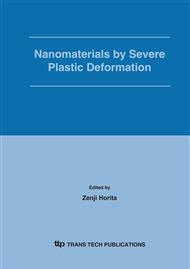p.505
p.511
p.515
p.521
p.527
p.533
p.539
p.545
p.551
Equal Channel Angular Pressing of Magnesium Alloy Containing Quasicrystal Phase
Abstract:
ZWK510 (Mg-5.0wt%Zn-0.9wt%Y-0.2wt%Zr) magnesium alloy containing Mg3YZn6 quasicrystal phase was prepared by conventional permanent mold casting. Part of the cast ingot was subjected to equal channel angular pressing (ECAP) directly; another part of the cast ingot was extruded initially, then ECAP was applied to the extruded alloy. After 4-pass ECAP, the fraction of coarse grains of the as-cast alloy was decreased to about 30%, and the grain size of fine grain was decreased to about 2 μm. Both strength and ductility of the as-cast ZWK510 alloy were significantly improved with increasing ECAP passes, which was resulted from broken and dispersed I-phase, and fine grains formed due to recrystallization. The as-extruded ZWK510 had an initial grain size of about 2 μm and bands of quasicrystal phase parallel to the extrusion direction. After the extruded alloy was subjected to ECAP, the grain size of the extruded alloy was further refined, the grain size was refined to below 0.5 um after 8-pass ECAP; and the quasicrystal phase was further broken and dispersed in the matrix. After ECAP, the elongation to failure of the extruded alloy was improved. However, both yield strength and ultimate tensile strength were decreased, which is considered to be resulted from the texture modification during ECAP.
Info:
Periodical:
Pages:
527-532
Citation:
Online since:
January 2006
Price:
Сopyright:
© 2006 Trans Tech Publications Ltd. All Rights Reserved
Share:
Citation:


